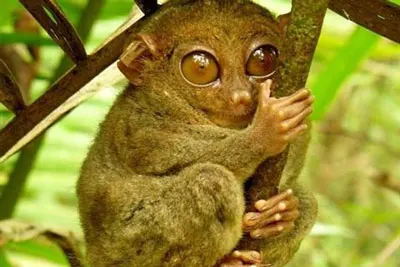Variety Overview
The Philippine tarsier is one of the smallest monkey species in existence today. Primarily found in Southeast Asia, these creatures are rarely seen outside their native regions. Due to their limited numbers, they are classified as an endangered species and are currently protected by national regulations.
Tarsiers are highly sensitive to changes in their habitat. Any destruction of their environment can lead to a significant decline in their population. Based on recent inspections and estimates, it is believed that there are only about 800 to 1200 tarsiers remaining in the forests of Sulawesi Island.
English Name: Philippine tarsier
Kingdom: Animalia
Phylum: Chordata
Subphylum: Vertebrata
Class: Mammalia
Subclass: Theria
Order: Primates
Suborder: Prosimii
Family: Tarsiidae
Distribution: Southern Sumatra and parts of the Philippine islands
Tarsiers are nocturnal creatures that typically build their homes in trees and live alongside other family members. They are roughly the size of a human fist and have long tails, making them resemble mice or squirrels at first glance. Interestingly, tarsiers are unique among primates for being exclusively insectivorous; they primarily feed on insects such as locusts, crickets (detailed introduction), flies, and mosquitoes.
Design Characteristics
A tarsier’s body is only about the size of an adult’s fist, resembling a squirrel rat in appearance. Ideally, an adult tarsier measures between 85-160mm in length and weighs between 80-165g. Its tail length typically surpasses its body length.
Tarsiers are among the smallest primates. Their back fur is soft with a silvery-gray sheen, while their belly fur is light gray. They have round heads with short snouts and necks, thin hairless ear shells, and remarkably large eyes measuring up to 16mm in diameter. Their forelimbs are short compared to their long hind limbs; they possess round suction pads on their toe tips allowing them to cling to many smooth surfaces. Their faces are forward-facing with a thin interorbital septum. Adapted for night vision, their retinas lack cones. All fingers and toes have flat nails except for claws on the second and third toes. The hind limbs are long with fused tibia and fibula bones; elongated tarsal bones give them their name “tarsier”. They also feature long slender tails ending in hairy tips.
Each eye of a tarsier can weigh up to 3 grams—heavier than its brain. Highly sensitive to danger, they often rest with one eye open. In proportion to their body size, tarsiers boast several records among primates: they have the largest eyes, largest ears, and longest toe bones.

Living Habits
Habitat
Tarsiers are arboreal animals inhabiting the dense tropical and subtropical forests of Southeast Asia. They thrive in dense secondary forests and thickets but can also be found in primary forests.
Reproduction Process
Female tarsiers have 2 to 3 pairs of nipples with a gestation period of around 180 days, typically giving birth to one offspring per litter. Newborns are approximately 6 centimeters long, covered with fur, and their eyes are already open at birth.
Survival Skills
Tarsiers can keep their bodies still while rotating their heads almost entirely around. This ability helps them detect prey and avoid predators such as owls and small cats. They are highly skilled at leaping between trees, capable of accurately jumping distances over 3 meters. They can walk on all fours or hop on the ground using their hind legs; they also climb trees and slide down trunks with ease. Their disc-shaped finger pads act like suction cups, aiding in climbing.
Typically solitary but sometimes living in pairs, each pair produces one offspring annually. Female tarsiers give birth after a six-month gestation period; newborns can immediately cling to their mothers or tree branches.
Tarsiers often move clumsily along branches but primarily get around by leaping. During leaps, they extend their long hind legs to jump into the air and land on another tree about 2 meters away; they can even change direction mid-leap if needed.
Newborn tarsiers are well-developed at birth with thick fur and open eyes; they can climb and cling to their mother’s fur right from birth. For longer journeys, mothers carry the young in their mouths.
Feeding Techniques

In the wild, tarsiers can live up to 15-20 years. However, these creatures aren’t suited for domestic life; once accustomed to their natural habitat, they’ll never leave it. Attempts to relocate them elsewhere—such as those made in the Philippines—have invariably failed due to their intense homesickness.
Wild tarsiers are extremely shy and unaccustomed to human interaction. Only a few that grow up in captivity tolerate gentle human contact. Besides sleeping and clinging idly to branches, their primary concern is eating insects.
Though they can move clumsily along branches at a slow pace, tarsiers typically get around by leaping. When they jump, they extend their long hind legs abruptly and spring into the air, landing on another tree about 2 meters away—and if needed—they can change direction mid-jump.
These arboreal animals inhabit the dense tropical forests of Southeast Asia—specifically on some Philippine islands and southern Sumatra in Indonesia. Deforestation in the Philippines has significantly reduced their natural habitat, pushing them towards extinction. With only one offspring per year due to already low numbers, tarsiers are now considered endangered.
Tarsiers possess an extraordinary ability: keeping their bodies still while rotating their heads almost completely around—helpful for spotting prey or evading predators like owls and small cats. They excel at jumping between trees over distances greater than 3 meters with precision; they also walk on all fours or hop/run using hind legs on ground level—and they’re adept climbers thanks to disc-shaped finger pads that work like suction cups for gripping surfaces securely.
Typically solitary creatures—though sometimes seen paired—they produce one offspring per pair annually after a six-month gestation period by females; newborns immediately grasp onto mothers’ fur or nearby branches upon birth.
Newborn tarsiers arrive well-developed—with thick fur coats & open eyes—and begin climbing & gripping mothers’ fur right from birth itself; if mothers need travel long distances—they carry babies gently within mouths throughout journey ahead.
